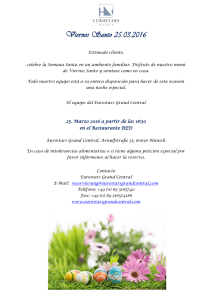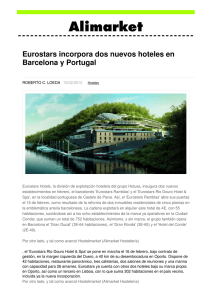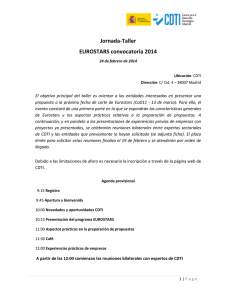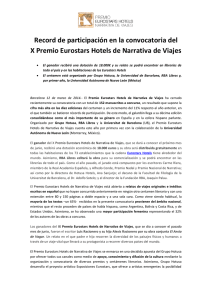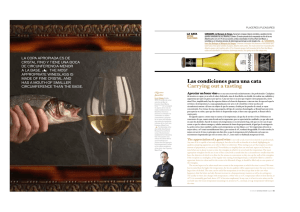mundo eurostars world
Anuncio
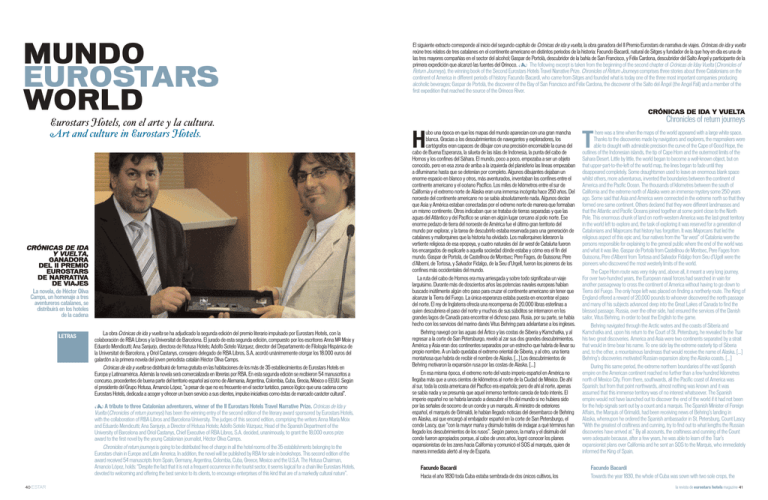
MUNDO EUROSTARS WORLD Eurostars Hotels, con el arte y la cultura. Art and culture in Eurostars Hotels. CRÓNICAS DE IDA Y VUELTA, GANADORA DEL II PREMIO EUROSTARS DE NARRATIVA DE VIAJES La novela, de Héctor Oliva Camps, un homenaje a tres aventureros catalanes, se distribuirá en los hoteles de la cadena LETRAS La obra Crónicas de ida y vuelta se ha adjudicado la segunda edición del premio literario impulsado por Eurostars Hotels, con la colaboración de RBA Libros y la Universitat de Barcelona. El jurado de esta segunda edición, compuesto por los escritores Anna Mª Moix y Eduardo Mendicutti; Ana Sanjurjo, directora de Hotusa Hotels; Adolfo Sotelo Vázquez, director del Departamento de Filología Hispánica de la Universitat de Barcelona, y Oriol Castanys, consejero delegado de RBA Libros, S.A, acordó unánimemente otorgar los 18.000 euros del galardón a la primera novela del joven periodista catalán Héctor Oliva Camps. Crónicas de ida y vuelta se distribuirá de forma gratuita en las habitaciones de los más de 35 establecimientos de Eurostars Hotels en Europa y Latinoamérica. Además la novela será comercializada en librerías por RBA. En esta segunda edición se recibieron 54 manuscritos a concurso, procedentes de buena parte del territorio español así como de Alemania, Argentina, Colombia, Cuba, Grecia, México o EEUU. Según el presidente del Grupo Hotusa, Amancio López, “a pesar de que no es frecuente en el sector turístico, parece lógico que una cadena como Eurostars Hotels, dedicada a acoger y ofrecer un buen servicio a sus clientes, impulse iniciativas como éstas de marcado carácter cultural”. 3 A tribute to three Catalonian adventurers, winner of the II Eurostars Hotels Travel Narrative Prize. Crónicas de Ida y Vuelta (Chronicles of return journeys) has been the winning entry of the second edition of the literary award sponsored by Eurostars Hotels, with the collaboration of RBA Libros and Barcelona University. The judges of this second edition, comprising the writers Anna María Moix and Eduardo Mendicutti; Ana Sanjurjo, a Director of Hotusa Hotels; Adolfo Sotelo Vázquez, Head of the Spanish Department of the University of Barcelona and Oriol Castanys, Chief Executive of RBA Libros, S.A. decided, unanimously, to grant the 18,000 euros prize award to the first novel by the young Catalonian journalist, Héctor Oliva Camps. Chronicles of return journeys is going to be distributed free of charge in all the hotel rooms of the 35 establishments belonging to the Eurostars chain in Europe and Latin America. In addition, the novel will be published by RBA for sale in bookshops. This second edition of the award received 54 manuscripts from Spain, Germany, Argentina, Colombia, Cuba, Greece, Mexico and the U.S.A. The Hotusa Chairman, Amancio López, holds: “Despite the fact that it is not a frequent occurrence in the tourist sector, it seems logical for a chain like Eurostars Hotels, devoted to welcoming and offering the best service to its clients, to encourage enterprises of this kind that are of a markedly cultural nature”. 40 ESTAR El siguiente extracto corresponde al inicio del segundo capítulo de Crónicas de ida y vuelta, la obra ganadora del II Premio Eurostars de narrativa de viajes. Crónicas de ida y vuelta reúne tres relatos de tres catalanes en el continente americano en distintos períodos de la historia: Facundo Bacardí, natural de Sitges y fundador de la que hoy en día es una de las tres mayores compañías en el sector del alcohol; Gaspar de Portolà, descubridor de la bahía de San Francisco, y Félix Cardona, descubridor del Salto Ángel y participante de la primera expedición que alcanzó las fuentes del Orinoco. 3 The following excerpt is taken from the beginning of the second chapter of Crónicas de Iday Vuelta (Chronicles of Return Journeys), the winning book of the Second Eurostars Hotels Travel Narrative Prize. Chronicles of Return Journeys comprises three stories about three Catalonians on the continent of America in different periods of history: Facundo Bacardí, who came from Sitges and founded what is today one of the three most important companies producing alcoholic beverages; Gaspar de Portolà, the discoverer of the Bay of San Francisco and Félix Cardona, the discoverer of the Salto del Ángel (the Angel Fall) and a member of the first expedition that reached the source of the Orinoco River. CRÓNICAS DE IDA Y VUELTA Chronicles of return journeys ubo una época en que los mapas del mundo aparecían con una gran mancha blanca. Gracias a los descubrimientos de navegantes y exploradores, los cartógrafos eran capaces de dibujar con una precisión encomiable la curva del cabo de Buena Esperanza, la silueta de las islas de Indonesia, la punta del cabo de Hornos y los confines del Sáhara. El mundo, poco a poco, empezaba a ser un objeto conocido, pero en esa zona de arriba a la izquierda del planisferio las líneas empezaban a difuminarse hasta que se detenían por completo. Algunos dibujantes dejaban un enorme espacio en blanco y otros, más aventurados, inventaban los confines entre el continente americano y el océano Pacífico. Los miles de kilómetros entre el sur de California y el extremo norte de Alaska eran una inmensa incógnita hace 250 años. Del noroeste del continente americano no se sabía absolutamente nada. Algunos decían que Asia y América estaban conectadas por el extremo norte de manera que formaban un mismo continente. Otros indicaban que se trataba de tierras separadas y que las aguas del Atlántico y del Pacífico se unían en algún lugar cercano al polo norte. Ese enorme pedazo de tierra del noroeste de América fue el último gran territorio del mundo por explorar, y la tarea de descubrirlo estaba reservada para una generación de catalanes y mallorquines que la historia ha olvidado. Los mallorquines lideraron la vertiente religiosa de esa epopeya, y cuatro naturales del far west de Cataluña fueron los encargados de explicarle a aquella sociedad dónde estaba y cómo era el fin del mundo. Gaspar de Portolà, de Castellnou de Montsec; Pere Fages, de Guissona; Pere d’Alberní, de Tortosa, y Salvador Fidalgo, de la Seu d’Urgell, fueron los pioneros de los confines más occidentales del mundo. La ruta del cabo de Hornos era muy arriesgada y sobre todo significaba un viaje larguísimo. Durante más de doscientos años las potencias navales europeas habían buscado inútilmente algún otro paso para cruzar el continente americano sin tener que alcanzar la Tierra del Fuego. La única esperanza estaba puesta en encontrar el paso del norte. El rey de Inglaterra ofrecía una recompensa de 20.000 libras esterlinas a quien descubriera el paso del norte y muchos de sus súbditos se internaron en los grandes lagos de Canadá para encontrar el dichoso paso. Rusia, por su parte, se había hecho con los servicios del marino danés Vitus Behring para adelantarse a los ingleses. Behring navegó por las aguas del Ártico y las costas de Siberia y Kamchatka, y al regresar a la corte de San Petersburgo, reveló al zar sus dos grandes descubrimientos. América y Asia eran dos continentes separados por un estrecho que habría de llevar su propio nombre. A un lado quedaba el extremo oriental de Siberia, y al otro, una tierra montañosa que habría de recibir el nombre de Alaska. [...] Los descubrimientos de Behring motivaron la expansión rusa por las costas de Alaska. [...] En esa misma época, el extremo norte del vasto imperio español en América no llegaba más que a unos cientos de kilómetros al norte de la Ciudad de México. De ahí al sur, toda la costa americana del Pacífico era española; pero de ahí al norte, apenas se sabía nada y se presumía que aquel inmenso territorio carecía de todo interés. El imperio español no se habría lanzado a descubrir el fin del mundo si no hubiera sido por las señales de socorro de un conde y un marqués. Al ministro de exteriores español, el marqués de Grimaldi, le habían llegado noticias del desembarco de Behring en Alaska, así que encargó al embajador español en la corte de San Petersburgo, el conde Lascy, que “con la mayor maña y disimulo tratéis de indagar a qué términos han llegado los descubrimientos de los rusos”. Según parece, la maña y el disimulo del conde fueron apropiados porque, al cabo de unos años, logró conocer los planes expansionistas de los zares hacia California y comunicó el SOS al marqués, quien de manera inmediata alertó al rey de España. H Facundo Bacardí Hacia el año 1830 toda Cuba estaba sembrada de dos únicos cultivos, los here was a time when the maps of the world appeared with a large white space. Thanks to the discoveries made by navigators and explorers, the mapmakers were able to draught with admirable precision the curve of the Cape of Good Hope, the outlines of the Indonesian islands, the tip of Cape Horn and the outermost limits of the Sahara Desert. Little by little, the world began to become a well-known object, but on that upper-part-to-the-left of the world map, the lines began to fade until they disappeared completely. Some draughtsmen used to leave an enormous blank space whilst others, more adventurous, invented the boundaries between the continent of America and the Pacific Ocean. The thousands of kilometres between the south of California and the extreme north of Alaska were an immense mystery some 250 years ago. Some said that Asia and America were connected in the extreme north so that they formed one same continent. Others declared that they were different landmasses and that the Atlantic and Pacific Oceans joined together at some point close to the North Pole. This enormous chunk of land on north-western America was the last great territory in the world left to explore and, the task of exploring it was reserved for a generation of Catalonians and Majorcans that history has forgotten. It was Majorcans that led the religious aspect of this epic and, four natives from the “far west” of Catalonia were the persons responsible for explaining to the general public where the end of the world was and what it was like. Gaspar de Portolà from Castellnou de Montsec, Pere Fages from Guissona, Pere d’Alberní from Tortosa and Salvador Fidalgo from Seu d’Ugell were the pioneers who discovered the most westerly limits of the world. The Cape Horn route was very risky and, above all, it meant a very long journey. For over two-hundred years, the European naval forces had searched in vain for another passageway to cross the continent of America without having to go down to Tierra del Fuego. The only hope left was placed on finding a northerly route. The King of England offered a reward of 20,000 pounds to whoever discovered the north passage and many of his subjects advanced deep into the Great Lakes of Canada to find the blessed passage. Russia, over the other side, had ensured the services of the Danish sailor, Vitus Behring, in order to beat the English to the game. Behring navigated through the Arctic waters and the coasts of Siberia and Kamchatka and, upon his return to the Court of St. Petersburg, he revealed to the Tsar his two great discoveries. America and Asia were two continents separated by a strait that would in time bear his name. To one side lay the extreme easterly tip of Siberia and, to the other, a mountainous landmass that would receive the name of Alaska. [...] Behring’s discoveries motivated Russian expansion along the Alaska coasts. [...] During this same period, the extreme northern boundaries of the vast Spanish empire on the American continent reached no further than a few hundred kilometres north of Mexico City. From there, southwards, all the Pacific coast of America was Spanish; but from that point northwards, almost nothing was known and it was assumed that this immense territory was of no interest whatsoever. The Spanish empire would not have launched out to discover the end of the world if it had not been for the help signals sent out by a count and a marquis. The Spanish Minister of Foreign Affairs, the Marquis of Grimaldi, had been receiving news of Behring’s landing in Alaska, whereupon he ordered the Spanish ambassador in St. Petersburg, Count Lascy “With the greatest of craftiness and cunning, try to find out to what lengths the Russian discoveries have arrived at.” By all accounts, the craftiness and cunning of the Count were adequate because, after a few years, he was able to learn of the Tsar’s expansionist plans over California and he sent an SOS to the Marquis, who immediately informed the King of Spain. T Facundo Bacardí Towards the year 1830, the whole of Cuba was sown with two sole crops, the la revista de eurostars hotels magazine 41 MUNDO EUROSTARS WORLD El autor Crónicas de ida y vuelta es el primer libro de Héctor Oliva (Barcelona, 1970), periodista que ha trabajado los últimos cinco años en el gabinete de prensa de la organización Intermón Oxfam. Es licenciado en CC. de la Información por la Universidad de Navarra y doctor en Derecho Constitucional por la UNED. The author Chronicles of Return Journeys is the first book by Héctor Oliva (Barcelona, 1970). Oliva is a journalist who has worked for the past five years in the Press Office of the Intermón Oxfam organization. He has a degree in Journalist by the University of Navarra and a doctorate in Constitutional Law by the Open University. indispensables para un buen desayuno dulzón: café y azúcar. Todo lo demás había que traerlo de fuera, y en una época de malas comunicaciones terrestres, la descarga de los barcos en la bahía de Santiago se convertía en el indispensable cordón umbilical de la ciudad. Ahí acudían los tenderos a proveerse de todo cuanto pudiera caber en sus almacenes. [...] Los tenderos de Santiago tenían una característica común: su origen. Lo insólito no es que todos fueran forasteros y vinieran de la península ibérica, es que todos procedían de un pequeño pueblo del litoral catalán abrigado por el macizo del Garraf. La fructífera historia de amor entre Sitges y Santiago de Cuba había empezado unos años antes y habría de prolongarse por espacio de más de cien años. essential elements for a good, sweet breakfast: coffee and sugar. Everything else had to be brought in from the outside and, at a time of poor land communications, the unloading of ships in the Bay of Santiago became the city’s indispensable umbilical cord. Shopkeepers flocked there to provide themselves with as much as they could store in their warehouses. [...] The Santiago shopkeepers all had a characteristic in common: their origin. The unusual thing is not that they were all foreigners and came from Spain but that they all came from one small village on the Catalonian coast, sheltered by the Garraf Massif. The fruitful love story between Sitges and Santiago de Cuba had begun years before and was to last for over a hundred years. Gaspar de Portolà Los indios edificarían y habitarían las 21 misiones que los padres franciscanos fundaron en la California que hoy pertenece a Estados Unidos. En territorio mexicano se fundaron un total de 28. La cadena de misiones fue espectacular porque, entre la que está más al sur y la situada más al norte, hay una distancia de 2.500 kilómetros, y la última de las misiones fue fundada cinco generaciones después de la primera. Los padres franciscanos encontraron en California una tierra fértil, donde crecía todo lo que en Cataluña y Mallorca habían cultivado años atrás. Junípero, Palou y Crespí fueron los iniciadores de lo que hoy en día es considerada como una de las mejores bebidas del mundo, el vino de California. El vino era imprescindible para la misa y, en un principio, llegaba en barco desde España hasta las misiones de California, pero después de que se registraran varios retrasos en las partidas y de que los frailes se quedaran algunas veces sin vino para la misa, decidieron hacerse traer unas cepas de La Rioja y el Penedès. Las plantaron y, con el tiempo, salió un vino tan sabroso que se convirtió en el inicio de una de las grandes industrias de California. Muchos años más tarde los viticultores de Cataluña y de media Europa habrían de agradecer con las manos tendidas al cielo esa primera cosecha de Junípero y compañía, porque, ahogados hasta el cuello por la filoxera, las únicas cepas que lograron hacer frente a la plaga después de muchos intentos fueron las de California, mucho más resistentes. Gaspar de Portolà The Indians were to build and inhabit the 21 missions that the Franciscan Fathers founded in California and that now belong to the United States. In Mexican territory they built a total of 28. The chain of missions was spectacular because there is a distance between the most southerly and northerly of 2,500 kilometres and, the last of the missions was founded five generations after the first. The Franciscan Fathers found fertile land in California, where they could grow everything that they had cultivated years before in Catalonia and Majorca. Junípero, Palou and Crespí were the initiators of what today is considered one of the best beverages in the world, Californian wine. Wine was indispensable for holding mass and in the early days, it was sent from Spain to the Californian missions but, after enduring several delays in the dispatches and the Brothers having many a time found themselves without any wine for the services, they decided to send for some vines from the Rioja and Penedès areas. They planted them and in time, the wine that was produced was so delicious that it became one of the largest industries in California. Many years later, the wine-growers of Catalonia and half of Europe were to give thanks, with their hands raised to the heavens, to that first crop planted by Junípero and company because, almost reduced to ruin by the phylloxera pest, the only strains that managed to resist the plague, despite several attacks, were the Californian variety, far stronger than the rest. Félix Cardona La locura del caucho acabó gracias al ingenio de los ingleses, que hartos de pagar tan caro el producto, tramaron el plan que habría de acabar con el monopolio del Amazonas y el Orinoco. La reina Victoria encargó la misión a Henry Alexander Wickham, quien llegó a Belem de Pará, contrató a unos cuantos cientos de indios y penetró en la selva aguas arriba del río Tapajós, hasta las cercanías de Canudos. Wickham logró cumplir el plan con una pulcritud encomiable. Estuvo con los indios varias semanas recolectando 70.000 semillas de hevea, envolviéndolas de diez en diez en hojas de banano para que sobrevivieran a la travesía del océano. Al pasar por Santarem y Pará declaró en las aduanas que su carga eran millones de nueces pecanas y los funcionarios le abrieron el paso del Atlántico sin saber que ponían fin al imperio del caucho. [...] Murieron casi todas las semillas, pero sobrevivieron algo más de dos millares, que fueron reembarcadas a las colonias británicas del sudeste asiático, sobre todo a Malasia e Indonesia. La misión de Wickham era un negocio a largo plazo, porque habrían de pasar casi cuarenta años para que las semillas recogidas en el Tapajós crecieran lo suficiente y empezaran a dar goma abundante para la industria de Liverpool y Manchester. [...] Pasaron cuarenta años y, efectivamente, las heveas de Malasia e Indonesia, ahora sí formando grandes bosques, lograron romper el monopolio del Amazonas y el Orinoco, y el gran negocio que fue el caucho quebró en menos de un año. Félix Cardona The rubber craze ended thanks to the ingenuity of the English who, sick and tired of paying the product at sky-high prices, thought out the plan that was to end the monopoly existing on the Amazon and Orinoco Rivers. Her Majesty, Queen Victoria, commissioned Henry Alexander Wickham to carry out the mission. He arrived at Belem de Parana, hired several hundred Indians and interned himself in the jungle, up the Tapajós River, until he reached the Canudos region. Wickham achieved the success of the plan with praiseworthy cleanness. He spent several weeks with the Indians harvesting 70,000 hevea seeds, wrapping them ten by ten in banana leaves so they would survive the ocean voyage, declaring at the Customs at Santarem and Parana that the cargo was millions of cashew nuts, so the officials let them through the Atlantic passage without imagining that they were putting an end to the rubber empire. [...] Nearly all the seeds died, except for something over two-thousand that were reshipped to the British Colonies in south-east Asia, particularly to Malaysia and Indonesia. The Wickham mission was a long-term business because almost forty years had to pass before the seeds picked along the Tapajós had grown and begun to produce rubber gum in sufficient abundance to supply the Liverpool and Manchester industries. [...] Forty years passed and, indeed, the hevea seeds in Malaysia and Indonesia that had become dense forests, managed to break the Amazon-Orinoco monopoly and, in less than a year, the enormous rubber industry went bankrupt. 42 ESTAR APOYO AL MEJOR CINE DOCUMENTAL DEL MUNDO Eurostars Hoteles participó como patrocinador de Docúpolis, el Festival Internacional de Cine Documental de Barcelona. CINE Eurostars Hotels fue uno de los patrocinadores de la sexta edición del festival Internacional de Cine Documental de Barcelona, organizado por Tercer OjoInternational Documentary Association. El primer premio, valorado en 6.000 euros, fue para el documental de Cristóbal Vicente, Arcana. El certamen barcelonés adjudicó el Premio Gran Angular al Cortometraje Documental Si no hay viento, no suben de Mauricio González, retrato de una banda juvenil de Colombia, que se podrá disfrutar a través del programa Gran Angular de TVE. El Premio Ópera Prima fue a parar al filme de David Martín de los Santos La isla durmiente, que será distribuido en cines por Ermedia. Además, en esta sexta edición se entregaron varios premios honoríficos, entre los cuales destaca el Premio el Hombre de la Cámara, que ha reconocido este año la trayectoria del maestro del documental holandés Joris Ivens, de quien se ha podido ver una amplia retrospectiva en Docúpolis 2006. El premio lo recogió Marceline Loridan, viuda de Joris Ivens y presidenta de la Fundación Europea Joris Ivens, quien durante su estancia en Barcelona se hospedó en el Eurostars Gaudí. 3 Support for the best documentary cinema in the world. Eurostars Hotels took part as sponsor of the Docupolis, International Documentary Cinema Festival of Barcelona. Eurostars Hotels was one of the sponsors of the sixth edition of the International Documentary Cinema Festival of Barcelona, organized by the Third Eye–International Documentary Association. The first prize, valued at 6,000 euros, went to Cristóbal Vicente’s documentary, Arcana. The Barcelona event awarded the Wide Angle Lens Prize to the Documentary Short Movie, Si no hay viento, no suben (If there is no wind they do not rise) by Mauricio González, a story about a gang of kids in Colombia that can be viewed and enjoyed on the TVE programme Gran Angular. The Opera Prima Prize went to the film by David Martín de los Santos La Isla durmiente (The Sleeping Island), that will be distributed to cinemas by Ermedia. Additionally, in this sixth edition various honorary prizes were awarded, amongst which the Cameraman Prize can be highlighted, that this year acknowledged the trajectory of a maestro of documentaries, the Dutchman Joris Ivens, whose comprehensive retrospective exhibition has been seen at the 2006 Ducopolis. The prize was collected by Marceline Loridan, Joris Ivens’s widow and president of the Joris Ivens European Foundation, who was accommodated at the Eurostars Gaudí during her stay in Barcelona. la revista de eurostars hotels magazine 43 EUROSTARS HOTELS EUROSTARS HOTELS EXPOSICIONES EXHIBITIONS EXPOSICIONES FUTURAS FORTHCOMING EXHIBITIONS Exposiciones de arte en nuestros hoteles. Art Exhibitions in our hotels. Málaga Eurostars Astoria HHH Gaguik Martirosyan 20/10/06 - 20/11/06 Ourense Eurostars Auriense HHHH Nuestros establecimientos acogen exposiciones de artistas locales o residentes en las ciudades en las que se ubican. Con esta iniciativa Eurostars Hotels pretende ofrecer a los jóvenes artistas una plataforma importante de promoción y comercialización de su obra. Las obras expuestas están a la venta. Si está interesado en adquirir alguna de ellas, pregunte en la recepción. Para ampliar información sobre la obra de los artistas que han expuesto o expondrán en las instalaciones de los establecimientos de Eurostars Hotels, puede consultar la página web: www.eurostarshotels.com/es/filosofia-exposiciones.html o contactar con Federica Di Matteo ([email protected]) Ester González Benedicto 11/10/06 - 11/11/06 Composiciones de Ràfols Casamada, en el Eurostars Anglí Coincidiendo con su Inauguración oficial, el Eurostars Anglí (Barcelona) acogió una muestra de las obras de Albert Ràfols Casamada (Barcelona, 1923) que se caracterizan por una elegancia compositiva de estructuras ortogonales, a la que se une una emotiva y luminosa sensibilidad cromática. Rafols Casamada es el autor de la obra “Aire de Mar”, que luce en la recepción del Eurostars Grand Marina HotelH H H HGL. 3 Compositions by Ràfols Casamada, at the Eurostars Anglí. To coincide with its Official Opening, the Eurostars Anglí (Barcelona) held an exhibition of work by Albert Ràfols Casamada (Barcelona, 1923), a characteristic of which is the elegance in its composition of octagonal structures, to which a touching and luminous chromatic sensitivity is joined. Rafols Casamada is the creator of the “Aire de Mar” (Sea Breeze) that i son display in the reception area of the Eurostars Grand Marina HotelH H H HGL. Barcelona Eurostars Barberà Parc HHHH Jordi Martínez Caralt 18/10/06 - 18/11/06 Patricia Muñoz 23/11/06 - 23/12/06 Eurostars Cristal Palace HHHH El Eurostars Mediterránea Plaza exhibe las obras de María Marta Guzzetti Ràfols Casamada. La artista argentina María Marta Guzzetti acercó sus grabados al Eurostars Mediterránea Plaza (Alicante). LA exposición incluía la serie “Signos y Señales” dedicados, según la propia artista a “la mujer, la naturaleza, las vivencias y los recuerdos”. 3 The Eurostars Mediterránea Plaza Displays work by María Marta Guzzetti. The Argentinian artist María Marta Guzzetti exhibited her engravings in the Eurostars Mediterránea Plaza (Alicante). The exhibition included the series “Signs and Signals”, dedicated, as stated by the artist herself, to “women, nature, experiences and recollections”. Paul Critchley. Los collages de Ricardo Olivares, protagonistas en el Eurostars Regina Our establishments house exhibitions by local or resident artists in the areas where they are located. By means of this initiative, Eurostars Hotels attempts to offer young artists an important promotional and commercial platform for their work as the exhibits are for sale. If you are interested in purchasing any one of them, please ask at the reception desk. For additional information about the work of the artists who have exhibited or who will be exhibiting in any of the Eurostars Hotels, kindly consult our website. www.eurostarshotels.com/en/filosofia-exposiciones.html or contact Federica Di Matteo ([email protected]) El artista sevillano Ricardo Olivares expuso recientemente algunas de sus más importantes piezas en el Eurostars Regina (Sevilla). Su obra destaca por el uso de la técnica del collage. 3 Collages by Ricardo Olivares, star figure at the Eurostars Regina. The Sevillian artist Ricardo Olivares exhibited some of his most important works at the Eurostars Regina (Seville). His use of the collage technique is the outstanding feature. Eurostars Parc del Vallés HHHH Elena Rubert 30/10/06 - 30/11/06 Olga Vidal 05/12/06 - 05/01/07 María Balcells 10/01/07 - 10/02/07 Conmovedores paisajes realistas en el Eurostars Ciudad de la Coruña ”Una fiel representación de paisajes gallegos urbanos y rurales”, es lo que disfrutaron los clientes del Eurostars Ciudad de la Coruña en la reciente exposición de la artista Pilar López. Con sus óleos sobre lienzo, López pretende reproducir las cosas bellas de la vida, empleando el realismo. 3 Poignant, realistic landscapes at the Eurostars Ciudad de La Coruña. “A faithful representation of town and country landscapes from Galicia” is what guests visiting the Eurostars Ciudad de la Coruña were able to enjoy at the recent exhibition by Pilar López. With her oils on canvas in realistic style, López attempts to reproduce the beautiful things in life. Eurostars Anglí HHHH Enrique Martín Subías 19/10/06 - 19/11/06 Xavi Muñoz 24/11/06 - 08/01/07 Susanne Hoppner 12/01/07 - 12/02/07 El Eurostars Las Adelfas alberga las pinturas de Victoria López Marta Guzzetti. El hotel cordobés albergó una exposición de las llamativas obras de la artista andaluza Victoria López. Esta artista ha recibido diferentes galardones entre los que se cuentan el Primer Premio Fotografía de la Semana Santa de Encinas Reales (Córdoba, 2001) o el Primer Premio Nacional de Escultura Círculo de Bellas Artes de Pozoblanco (Córdoba, 2004). 3 The Eurostars Las Adelfas houses paintings by Victoria López. The Cordova hotel housed a display of the expressive works by the Andalusian artist, Victoria López. This artist has received several awards, amongst which can be highlighted the Encinas Reales Holy Week Photography Prize (Cordova, 2001) or the Pozoblanco Fine Arts Circle National Sculpture Prize (Cordova, 2004). Paul Critchley exhibe sus lienzos en el Eurostars Cristal Palace El británico Paul Critchley expuso sus cuadros “supra-realistas” en las instalaciones del barcelonés Eurostars Cristal Palace. El autor autodefine sus obras como “domésticos, ya que la inspiración surge del propio entorno y refleja paisajes de la vida cotidiana”. 3 Paul Critchey exhibits his canvases at the Eurostars Cristal Palace. The British artist Paul Critchley exhibits his “supra-realist” paintings in the Barcelona Eurostars Cristal Palace Hotel. The artist defines his paintings as “domestic, inasmuch as inspiration emerges from the surroundings and they are a reflection of scenes from everyday life”. Ricardo Olivares. 44 ESTAR Collin McCallum 12/11/06 - 12/12/06 María Julieta Díaz 17/12/06 - 17/01/07 Magalí Ávila 22/01/07 - 22/02/07 Para más información: [email protected] A Coruña Further information: [email protected] Eurostars Ciudad de la Coruña HHHHH María Fernanda Candal 30/10/06 - 30/11/06 Valencia Eurostars Gran València HHHHH Elena Rubert & Chris Amat 11/11/06 - 11/12/06 Alicante Eurostars Mediterránea Plaza HHHH Inmaculada Companis 21/10/06 - 21/11/06 Esther González Benedicto 26/11/06 - 28/12/06 Roma Eurostars Roma Congress HHHH Fondo Int. Orvieto Fotografía 24/10/06 - 25/11/06 Giovanni Liberatore 26/11/06 - 26/12/06 Roberto Castellucci 27/01/07 - 27/02/07 Sevilla Eurostars Regina HHH Isabel Carrión 26/10/06 - 26/11/06 Toledo Eurostars Toledo HHHH Rafael Alonso Cumplido 25/10/06 - 25/11/06 Eurostars Grand Marina H H H H H GL Madrid Artistas de Zimbawe 12/01/07 - 12/03/07 Eurostars Zarzuela Park HHHH Eurostars Laietana Palace HHHH Victoria López. Gerard Solà 20/01/07 - 20/02/07 Isabel Romero - Maite Granda 05/11/06 - 05/12/0 Rocío Ahnert 10/11/06 - 10/12/06 Margarita Balmaceda 15/12/06 - 15/01/07 la revista de eurostars hotels magazine 45
